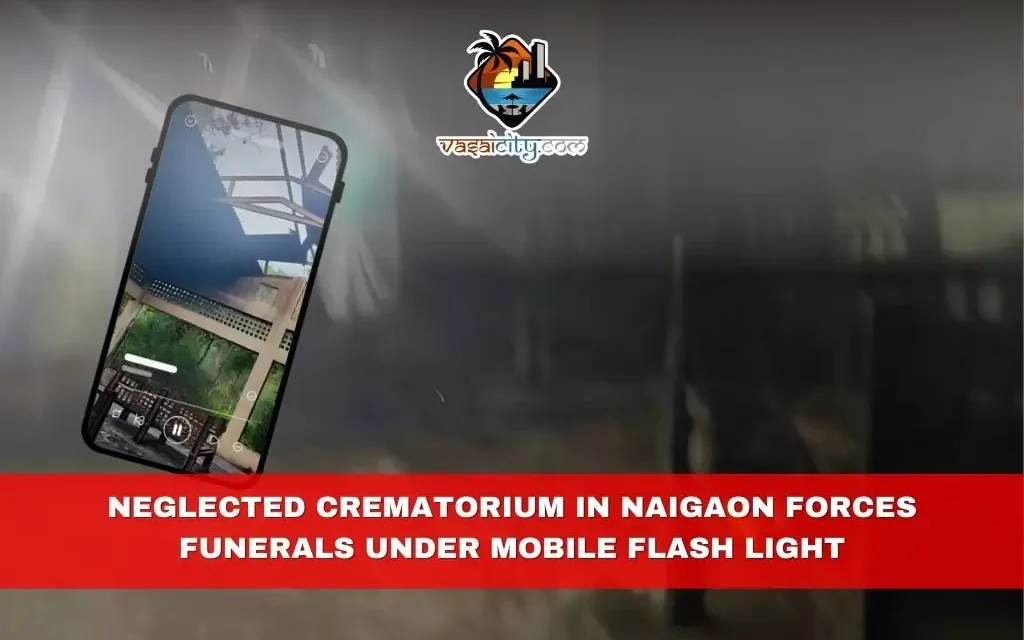In the quiet town of Naigaon in Vasai, a tragic and unsettling situation has emerged. The local crematorium, located in the coastal area of Naigaon Koliwada in the western part of the town, has fallen into a state of severe disrepair. This neglected facility has left residents struggling, particularly during funerals that occur at night. With no proper electricity or adequate maintenance, grieving families are forced to perform final rites in the most challenging conditions—using mobile phone flashlights to light the way.
A Crematorium in Crisis
Naigaon Koliwada is a peaceful fishing village in the west of Naigaon, but unfortunately, its crematorium is far from being a peaceful resting place for the departed. Built to serve the local community, the crematorium has become a symbol of municipal neglect. Residents are now raising their voices about the shocking state of this essential facility, which has been left to deteriorate to an alarming extent.
For the last one and a half months, the crematorium’s condition has been worsening. One of the most glaring issues is the absence of electricity. As night falls, the entire cremation area is engulfed in darkness, making it nearly impossible to carry out rituals without artificial lighting. The lack of even the most basic amenities has made the cremation process highly stressful for families mourning their loved ones.
A local resident described a recent funeral where, due to the absence of electricity, they had to use the headlights of scooters and mobile phone flashlights to perform the last rites. “It was heartbreaking enough to lose a loved one, but to not even have a proper cremation was just unbearable,” said one of the mourners.
No Shelter from the Elements
The issues at the Naigaon crematorium go beyond the lack of electricity. During the monsoon season, the problems only escalate. The roof of the crematorium is in terrible condition, with broken sheets that allow rainwater to pour directly onto the funeral pyres. This leads to significant complications during cremations, as waterlogged wood does not burn properly, causing delays and further distress for grieving families.
“When the rain comes down, it hits directly on the pyre, making it very difficult to continue with the cremation,” explained another local. “Sometimes, the wood becomes too wet to ignite, and we have to make multiple attempts just to get the fire started.”
The structure’s iron pillars, which support the roof, are rusted and weakened from years of neglect. Many of the metal supports have corroded to such an extent that locals fear they may collapse at any moment. The protective nets that were once installed to safeguard the area are now in tatters, offering little to no protection. The general sense of decay around the crematorium has led to an increased risk of accidents and injuries during funerals.
A Cry for Help
The residents of Naigaon Koliwada are rightfully outraged by the state of their crematorium. For a place meant to offer dignity to the deceased and solace to the living, its current condition is anything but respectful. The residents have repeatedly called on the local municipal authorities to intervene and provide the much-needed repairs and upgrades to this crucial facility.
Their complaints have gone largely ignored. Despite the residents’ best efforts to bring attention to the problem, no significant action has been taken by the local governing bodies. The residents accuse the municipality of neglecting the crematorium and failing to maintain basic standards of safety and sanitation.
One particularly distressing funeral recently brought the issue back into the spotlight. A body was brought to the crematorium for its final rites late in the evening, but with no power, the entire area was cloaked in darkness. Grieving family members had no choice but to rely on their mobile phones and scooter headlights to provide the necessary illumination. It was a moment that underlined the deep frustration of the community.
“We have been telling the municipality about these problems for months, but no one listens,” said a resident. “We are asking for basic things—proper lighting, a roof that doesn’t leak, and safety measures. These are not luxuries; they are necessities.”
The Way Forward
For the people of Naigaon, the situation at their crematorium is a daily reminder of the local government’s apathy. The residents are now calling for urgent repairs and improvements, including:
- Electrical Installation: Installing a proper electrical system is the top priority. Having reliable lighting is essential, especially for night-time cremations.
- Roof Repairs: The broken sheets on the roof need to be replaced immediately to prevent rainwater from disrupting funeral services.
- Structural Maintenance: The rusting iron pillars and other structural components must be repaired or replaced to ensure the safety of all who visit the crematorium.
- Sanitation and Safety Upgrades: The crematorium needs to be cleaned and maintained regularly to avoid further deterioration, and safety nets or barriers should be reinstalled to protect those attending funerals.
The residents are hopeful that by bringing these issues to the public’s attention, they will be able to pressure the municipality into taking action. A functioning crematorium is a basic requirement for any community, and Naigaon Koliwada’s residents are determined to see that theirs is restored to a state of respect and dignity.
A Community’s Plea
As Naigaon Koliwada grapples with the crumbling state of its crematorium, the broader question of municipal accountability looms large. The residents, many of whom have grown up in the area and have deep ties to the community, feel a sense of betrayal from the local authorities. They hope that their appeals will finally be heard, and that future funerals will not be marred by the indignities of poor infrastructure.
“We just want our loved ones to have the respect they deserve,” said another resident. “This is the last thing we can do for them. It shouldn’t be this hard.”
It is now up to the authorities to listen to the voices of Naigaon’s residents and restore the crematorium so that it can serve the community with the dignity it was intended to provide.









